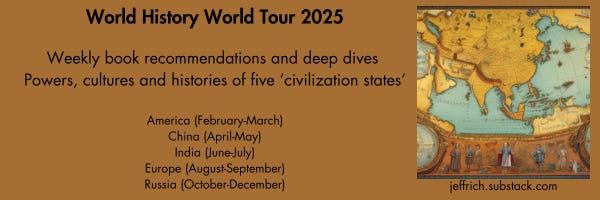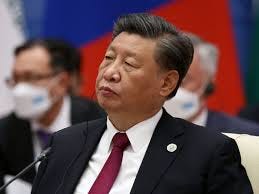Contemporary China and the riddle of the modern
Final deep dive into Making China Modern: from the Great Qing to Xi Jinping
Many Western observers believe that the principal question to ask about China’s political future is, will China marry democratic liberal reforms to its economic powerhouse? The question is personified by Xi Jinping. But I disagree. The key question to ask is the riddle of the modern.
Welcome to the final instalment of my eight-week deep dive into China as a modern civilization-state. This deep dive guides you through one leading scholarly history—Klaus Mühlhahn, Making China Modern: From the Great Qing to Xi Jinping—as part of my World History World Tour 2025.
The eighth instalment looks at contemporary China under the leadership of Xi Jinping. We ask the riddle of the modern. Will China become like the modern West? Or, will it follow its own path to modernity? Or does China’s blooming civilization state break the mould of modernity that has dominated political and historical thinking since the twentieth century?
Modernity is an idea that stalks our historical sensibility. Treated as the adjective, modernist, it describes the aesthetic sensibility that our jaded post-modernity has not yet shed. Turned into the verb, modernise, the idea demands that our societies get with the program. Abstracted further into a process, modernisation, the idea haunts assumptions of how politics, economies and societies should develop to become advanced nations. In the 1950s and 1960s modernisation was the openly proclaimed goal of social scientists who charted the path backward societies (in the ex-colonial third world) could take to become the advanced societies of the West. Most of us still think with these conceptual tools.
The spectres of modernity, modernism and modernisation have not left history or the social sciences, especially its most commercially successful variant, economics. You see the ghost of the idea even in the title of Klaus Mühlhahn’s Making China Modern.
In some ways, the modern is the narrative hinge between past and present. It is a device to give a narrative conclusion to the formless, never-ending chaos of real history. It is the point at which historians step away from the long view onto the past and offer their bounded, banal commentary on current events. Historians may claim some authority from reading more than most about the past. They rarely display greater acuity about the present than anyone else. We will always be in the dark about the future.
But arguments about modernity start from assumptions about how the West relates to the Rest, and how societies have changed over the course of history. They are not imperial fabrications. They find patterns in observed facts. Many changes coincided across the world, sometime between 1780 and 1914, in a way to define a new way of being in the world, the birth of the modern world. Historians, philosophers, sociologists, cultural theorists, and those oxymoronic political scientists have puzzled over this strange phenomenon for a century. It was there in Spengler’s Decline of the West in 1919, and Thomas Mann’s Magic Mountain of 1924. There was a big question to adapt to a changed world. As Virginia Woolf once wrote, how did human character change one day in 1910? How did Greater Europe (that is, Europe, North America, and the Russian world) rise to dominate the world, at their peak of power in the late nineteenth and early twentieth centuries? This is the riddle of the modern.
What is the riddle of the modern?
The Riddle of the Modern is the title of an influential book by Alan Macfarlane, The Riddle of the Modern World: Of Liberty, Wealth and Equality. Macfarlane’s book makes an argument that modernity arose first in England and Japan. His vision of modernity was of a more decentralised, complex society than the authoritarian monarchies of continental Europe and or the despotic states of Asia.
But many historians have puzzled through this riddle and offered other comparisons, different special paths, and alternative versions of history. In many ways ,Max Weber’s historical sociology, which is the tradition in which Mühlhahn writes, is a response to the riddle of the modern.
In contemporary global history, Christopher Bayly, The Birth of the Modern World, 1780-1914 is widely considered one the deepest reflections on this riddle. His introduction sets out the riddle as one of three central historiographical problems of his book. What was the birth of the modern? How was it experienced in all parts of the world? How do you write the history of this modernity, without falling into the thinking traps of modernisation theory or lazy assumptions about the never-ending superiority of the West?
Bayly argued that over the period from 1780 to 1914 (which in Mühlhahn’s history takes us from the Fall of the Qing to the Birth of the Modern Chinese Nation), there was a real global phenomenon of the birth of the modern.
“It encompassed the rise of the nation-state, demanding centralization of power or loyalty to an ethnic solidarity, alongside a massive expansion of global commercial and intellectual links. The international spread of industrialization and a new style of urban living compounded these profound developments. The merging of all these trends does point to a step-change in human social organization.”
(Bayly, The Birth of the Modern World, p. 11)
Moreover, he argued differing civilization-states converged over this period. Although previous globalisations, such as the Mongol and Columbian exchanges, promoted some convergence around the globe, this process intensified in the modern period.
“After about 1750, however, the scale of social organization and aspiration became vastly wider in the course of perhaps two generations. More rapid communications, larger political entities, and more ambitious ideologies of “civilization,” Western and non-Western, powered this change. At the same time, societies became internally more complex and more stratified. Differences of wealth and power became more glaring.”
(Bayly, The Birth of the Modern World, p. 12)
This is the riddle that launched a thousand histories of the rise of the West. We have read about these processes in Mühlhahn’s sophisticated adaptation of the modernisation narrative. But there is a critical subtlety in Bayly’s argument.
Modernity, then, was not only a process, but also a period which began at the end of the eighteenth century and has continued up to the present day in various forms.
(Bayly, The Birth of the Modern World [2004], p. 11)
If modernity is a period, then that period will end. We might ask if our persistent sense of polycrisis reflects, indeed, the fact that that period has ended. If the modern world was born some time before 1914, has the modern world died sometime after 1976, and even as a result of China’s great transformation?
Do we interpret contemporary China’s story as a late, socialist, oriental version of modernity? Or do we read China’s astonishing transformation, together with the more equal balance of power across the world, as a sign that modernity itself has ended, and yielded to a period whose name struggles to be born?
Asking the riddle of modern China
My reading of Mühlhahn’s final chapter, Ambitions and Anxieties: Contemporary China is below the line.
Please become a paid subscriber to get more of my insights, book recommendations and deep dives into how history can reveal the hidden patterns of our changing world.




